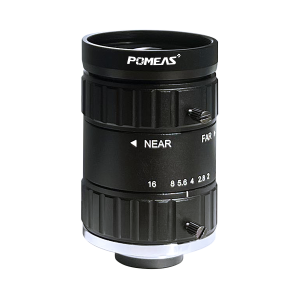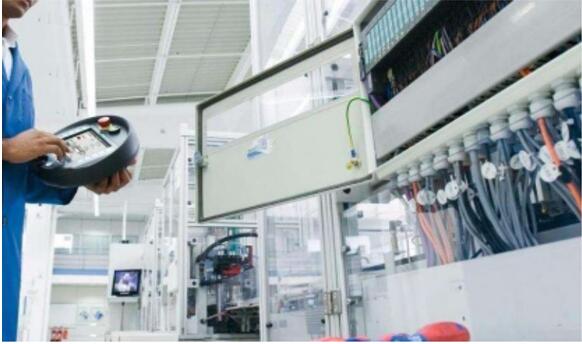In the industrial vision system, the connection between industrial lens and camera is crucial, and the interface is the key bridge between the two to realize the connection. Different interface types have their own characteristics and applicable scenarios, once you choose the wrong interface, it may cause a series of compatibility problems, affecting the normal operation of the entire vision system.


Common Industrial Lens Interface Types
1、C interface
The C interface is a widely used type of interface in the industrial field. Its thread specification is M25×0.75, and the distance from the lens mounting flange to the focal plane is 17.526mm. C interface lens is more versatile and can be adapted to many different types of cameras. Due to its mature technology and wide range of applications, it has been used in a large number of traditional industrial inspection, security monitoring and other fields. For example, in the circuit board for the appearance of the industrial camera system, you can often see the figure of the C interface industrial lens.
2、CS interface
CS interface and C interface is more similar to the same thread specifications for the M25 × 0.75, but the lens mounting flange to the focal plane distance is only 12.5mm. CS interface lens is relatively thinner and lighter, suitable for some of the volume and weight of the strict requirements of the equipment, such as small industrial cameras, portable testing equipment. In the field of intelligent transportation, used to capture illegal vehicles, many of the small cameras are equipped with CS interface industrial lens.
3、F interface
F interface is a lens interface introduced by Nikon, which is characterized by a larger bayonet diameter, usually used for large-size image sensor camera and lens combination.F interface thread specifications for the M42 × 1, the lens mounting flange to the focal plane of the distance is 46.5mm.Because of its large diameter design, to better transmit light, to ensure the quality of the image, so in the imaging quality of the requirements of high quality scientific research, high-end industrial inspection, etc. scientific research, high-end industrial inspection and other areas of application. For example, in the semiconductor chip manufacturing process of high-precision detection, will use the F interface industrial lens.
4、M42 interface
M42 interface is named after its 42mm thread diameter, the pitch is usually 1mm, it is a classic type of interface, has a long history, widely used in the field of photography in the early days, and later gradually in the industrial field, the advantages of the M42 interface lens is good versatility, can be connected to a variety of different interfaces with a variety of cameras through the adapter ring. In some of the need for flexible configuration of the vision system in the scene, the M42 interface lens of this advantage has been fully realized, such as in some small scientific research projects, researchers can use the M42 interface lens through the adapter ring to adapt to different brands of cameras to meet the experimental needs.
5、M58 interface
M58 interface thread diameter of 58mm, compared with other interfaces, its size is larger. This interface is mainly used for some special-purpose industrial lenses, such as large-diameter, telephoto lenses. Because its larger size can accommodate more optical elements, it has a unique advantage in industrial inspection scenarios that require high-magnification imaging and long-distance shooting. For example, telephoto industrial lenses equipped with the M58 interface may be used in remote condition monitoring of large machinery and equipment.
Impact of choosing the wrong interface on camera adaptation


1, physical connection problems
If the industrial lens interface does not match the camera interface, the first thing you will face is the inability to realize the physical connection. For example, the C interface lens can not be directly mounted on the CS interface camera, because their flange focal length is different, forcible installation may damage the lens or camera interface. Even through some inappropriate ways to achieve the connection, but also can not guarantee the coaxiality and stability between the lens and the camera, which will lead to a decline in imaging quality, image blurring, distortion and other issues.
2, optical performance mismatch
Different interface types are designed to take into account different optical performance requirements. Choosing the wrong interface may lead to the optical performance of the lens can not be perfectly matched with the camera. For example, the F interface lens is designed for large-size image sensors, if it is installed on a small-size sensor camera, there will be a serious dark corner of the image, edge resolution degradation and other issues. Because the image field of the lens can not fully cover the camera's sensor, resulting in only the center part of the image can be normal imaging, while the edge of the part can not get enough light and clear imaging.
3, electrical compatibility issues
In addition to the physical connection and optical performance matching, some industrial lenses and cameras also exist between the electrical connection for the transmission of control signals, data, etc.. Choosing the wrong interface may lead to electrical compatibility problems, such as the camera can not correctly identify the parameters of the lens, can not realize the autofocus, auto iris control and other functions. In some automated production lines, the lack of these functions can seriously affect the detection efficiency and accuracy, reducing the degree of automation of the entire production system.
How to choose the right interface
1, clear camera interface type
In the choice of industrial lenses, the first thing to be clear about the type of interface used by the camera. This can usually be obtained from the camera's product manual, logo or manufacturer of relevant information. Only understand the camera's interface, in order to target the selection of industrial lenses to match.
2, consider the application requirements
In addition to matching the interface, you also need to choose the right industrial lens according to the specific application requirements. For example, if you need high-resolution imaging and large field of view, you may need to choose the F interface of the large size lens; if the volume of the equipment has strict requirements, then the CS interface of the thin lens may be more appropriate. At the same time, but also consider the focal length of the lens, aperture, depth of field and other parameters to ensure that it can meet the requirements of the actual inspection task.
There are various types of interfaces for industrial lenses, each of which has its own unique characteristics and scope of application. In the construction of industrial vision systems, the correct choice of industrial lens interface is critical, it is not only related to the lens and the camera can be properly connected, but also directly affects the image quality and performance of the entire system.
Product recommendation
TECHNICAL SOLUTION
MORE+You may also be interested in the following information
FREE CONSULTING SERVICE
Let’s help you to find the right solution for your project!


 ASK POMEAS
ASK POMEAS  PRICE INQUIRY
PRICE INQUIRY  REQUEST DEMO/TEST
REQUEST DEMO/TEST  FREE TRIAL UNIT
FREE TRIAL UNIT  ACCURATE SELECTION
ACCURATE SELECTION  ADDRESS
ADDRESS Tel:+ 86-0769-2266 0867
Tel:+ 86-0769-2266 0867 Fax:+ 86-0769-2266 0867
Fax:+ 86-0769-2266 0867 E-mail:marketing@pomeas.com
E-mail:marketing@pomeas.com
